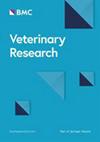Duck hepatitis A virus utilizes PCBP2 to facilitate viral translation and replication
IF 3.7
1区 农林科学
Q1 VETERINARY SCIENCES
引用次数: 0
Abstract
Duck hepatitis A virus type 1 (DHAV-1) is an important member of the Picornaviridae family that causes highly fatal hepatitis in ducklings. Since picornaviruses have small genomes with limited coding capacity, they must utilize host proteins for viral cap-independent translation and RNA replication. Here, we report the role of duck poly(rC)-binding protein 2 (PCBP2) in regulating the replication and translation of DHAV-1. During DHAV-1 infection, PCBP2 expression was upregulated. A biotinylated RNA pull-down assay revealed that PCBP2 positively regulates DHAV-1 translation through specific interactions with structural domains II and III of the DHAV-1 internal ribosome entry site (IRES). Further studies revealed that PCBP2 promotes DHAV-1 replication via an interaction of its KH1 domain (aa 1–92) with DHAV-1 3Dpol. Thus, our studies demonstrated the specific role of PCBP2 in regulating DHAV-1 translation and replication, revealing a novel mechanism by which host‒virus interactions regulate viral translation and replication. These findings contribute to further understanding of the pathogenesis of picornavirus infections.鸭甲型肝炎病毒利用 PCBP2 促进病毒翻译和复制
鸭甲型肝炎病毒 1 型(DHAV-1)是短小病毒科(Picornaviridae)的一个重要成员,可导致雏鸭发生高度致命的肝炎。由于短小病毒的基因组较小,编码能力有限,因此它们必须利用宿主蛋白进行病毒帽无关翻译和 RNA 复制。在此,我们报告了鸭多聚(rC)结合蛋白 2(PCBP2)在调节 DHAV-1 复制和翻译中的作用。在 DHAV-1 感染期间,PCBP2 的表达上调。生物素化 RNA 拉低试验显示,PCBP2 通过与 DHAV-1 内部核糖体进入位点(IRES)的结构域 II 和 III 的特异性相互作用,对 DHAV-1 的翻译起着积极的调控作用。进一步的研究发现,PCBP2 通过其 KH1 结构域(aa 1-92)与 DHAV-1 3Dpol 的相互作用促进了 DHAV-1 的复制。因此,我们的研究证明了 PCBP2 在调节 DHAV-1 翻译和复制中的特殊作用,揭示了宿主-病毒相互作用调节病毒翻译和复制的新机制。这些发现有助于进一步了解皮卡病毒感染的发病机制。
本文章由计算机程序翻译,如有差异,请以英文原文为准。
求助全文
约1分钟内获得全文
求助全文
来源期刊

Veterinary Research
农林科学-兽医学
CiteScore
7.00
自引率
4.50%
发文量
92
审稿时长
3 months
期刊介绍:
Veterinary Research is an open access journal that publishes high quality and novel research and review articles focusing on all aspects of infectious diseases and host-pathogen interaction in animals.
 求助内容:
求助内容: 应助结果提醒方式:
应助结果提醒方式:


